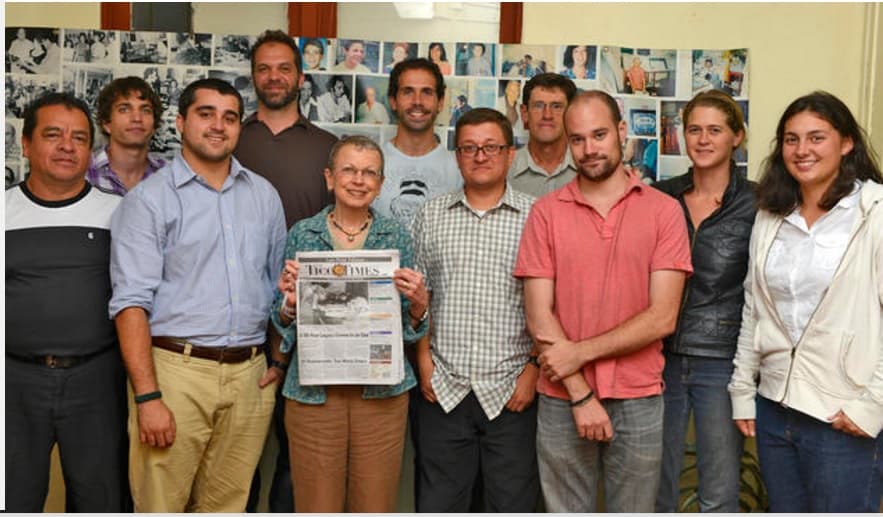We are proud to share this reflection from our former Editor and Publisher Dery Dyer, daughter of Tico Times Founder Elisabeth Dyer and Publisher Richard Dyer, as we celebrate our 60th Anniversary.
A classmate from my U.S. prep school recently sent me the following comment after I’d thanked her for sending me photos of our 50th class reunion:
“What would have been unimaginable 50 years ago is that you saw my photos in a computer (what is that?) and that you sent me a missive from Costa Rica via a cloud of electrons that reached me within 5 minutes on a crosstown bus in New York, and that I read the missive on a telephone.”
Just as unimaginable 60 years ago — or even 10! — was that someday The Tico Times would be reaching its readers via that same cloud of electrons. So, on the TT’s 60th birthday, I’d like to offer a toast: not only to the newspaper, but also to the memory of its Circulation Department.
After making sure you received your paper week after week for so many years, this once-essential department vanished overnight — deleted as swiftly and as totally as if a key had been pressed — when The Tico Times went online-only in 2012.
It was hard to believe. Circulation had always been the department that made all the others’ work worthwhile. It got the news into the readers’ hands and spread the word about Costa Rica around the world.
It also bonded us with our readers. Every subscriber — whether in Alajuela or Afghanistan (yep, we had readers in Afghanistan!) — was a real person who had become part of our worldwide community. Our readers turned into friends: they’d write chatty little notes on their renewal notices, send us comments, photos and articles, and drop by the office to say hello.
In the beginning, there was no Circulation Department. Everybody at The Tico Times did everything. When wearing our Circulation hats, we worked with little file boxes containing each subscriber’s address and subscription status typed on index cards.
Every week we spent hours typing labels on sheets of paper, cutting them out with scissors and sticking them on the newspapers with white glue. Before long we were photocopying the sheets of paper so we didn’t have to type all the addresses each week, but we were still cutting and pasting.
Then we acquired a nifty little machine which printed address labels from metal plates that had to be laboriously engraved on another little machine, and the Circulation Department was born. It had its own staff and was required to keep track of subscriptions, sales, and press runs in order to generate the all-important Circulation Reports.
Little by little, computers arrived, making everything a lot easier. But as the paper grew, so did the circulation challenges.
Every day there were subscriptions to be processed, renewal notices to be sent out, sales points to be checked and restocked… all of it leading up to Thursday nights, the Circulation Department’s adrenaline-fueled equivalent of the newsroom’s deadline, when the team worked feverishly all night manhandling piles of freshly printed newspapers so that the world could read us.
Staffers loaded bundles of papers onto waiting trucks bound for sales points in the provinces. Then they bundled papers for the home-delivery guys waiting with their motorcycles and route lists; counted stacks of papers to give drivers for distribution to sales points around the Central Valley; and labeled, stamped and sorted piles of papers into color-coded batches for the mail subscribers. These were rushed to the Post Office to be sent all over the country and to the many different areas of the world — the Americas, Europe, Asia, Oceania — where our subscribers lived.
Over time, the number of subscribers in the United States and Canada grew so large that we started air-freighting packages of papers to Miami and mailing them in bulk from there, which meant tearing to the airport as soon as they came off the press to get them on the earliest possible flight.
Later it made more sense to print the North America-bound papers in the U.S. This required making an extra set of page negatives and another frantic airport dash on Thursday evenings to get them ASAP to our U.S. printer.
Once again, computer technology eventually speeded things up, enabling us to ship the pages electronically; however, the Thursday-night marathon in Costa Rica continued for all the papers going elsewhere.
The entire circulation routine was so tightly coordinated that the slightest glitch along the way — if we were late getting on or off the press, if a plane couldn’t land, if a holiday meant the Post Office was closed, if a delivery guy was out sick — provoked a whole chain of chaos and an avalanche of complaints the following week, each of which had to be answered with a personal letter, phone call or e-mail, as well as with replacement copies rushed out by messenger or first-class mail.
The Circulation Dept. ended up being the most dramatic casualty of The Tico Times’ switch to digital delivery because an entire busy, hard-working world went extinct without leaving a single trace of its existence. There’s simply no equivalent in the newspaper’s online incarnation to remember it by. (The dinosaurs, at least, left fossils.)
So here’s to its memory! We could never have imagined a newspaper without paper, or without a Circulation Department to circulate it. But then, can any of us imagine how people will be getting their news 60 years from now?







